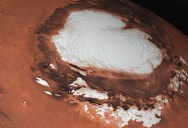There’s Enough Ice On Mars To Cover The Entire Planet In A 5-Foot Ocean If It Melted

The more the rovers do their thing on Mars, sending back numbers and metrics and photographs and thermal imaging and the like, the more good news NASA finds.
At least, as far as the planet’s potential ability to sustain life – and finding water (or ice) is a big part of that.
The European Space Agency’s Mars Express orbiter recently sent back data that suggests a huge deposit of water ice – the Medusae Fossae Formation (MFF) – is large enough to cover all of Mars in a 5-8ft deep ocean.
That is, if it melted for some reason.

Previously, scientists debated whether or not the MFF was mostly volcanic ash.
Tom Watters, lead author and Smithsonian Institution scientist, is excited.
“Dry material, no matter what it is, just doesn’t fit. We just can’t come up with another material other than water ice that fits the electrical properties, that also has this layering that we’re finding.”
This will likely make the equator a strong contender as a location for a visit.
“We’ve explored the MFF again using newer data from Mars Express’s MARSIS radar, and found the deposits to be even thicker than we thought: up to 2.3 miles thick. Excitingly, the radar signals match what we’d expect to see from layered ice, and are similar to the signals we see from Mars’s polar caps, which we know to be very ice rich.”
Initial measurements, taken in 2007, suggested this might be the case. Because of high winds in the area, though, they couldn’t rule out that the resulting geographical features were formed from dust, ash, or sediment.
“Given how deep it is, if the MFF was simply a giant pile of dust, we’d expect it to become compacted under its own weight. This would create something far denser than what we actually see with MARSIS.”
That said, the ice deposits do seem to be trapped beneath several hundred feet of dust or ash.

As with all scientific exploration, we’re left with more questions than answers.
“This latest analysis challenges our understanding of the Medusae Fossae Formation, and raises as many questions as answers. How long ago did these ice deposits form, and what was mars like at that time? If confirmed to be water ice, these massive deposits would change our understanding of Mars climate history. Any reservoir of ancient water would be a fascinating target for human or robotic exploration.”
I’m sure this is just one in a line of many fascinating findings in the years to come.
If you think that’s impressive, check out this story about a “goldmine” of lithium that was found in the U.S. that could completely change the EV battery game.

Sign up to get our BEST stories of the week straight to your inbox.




